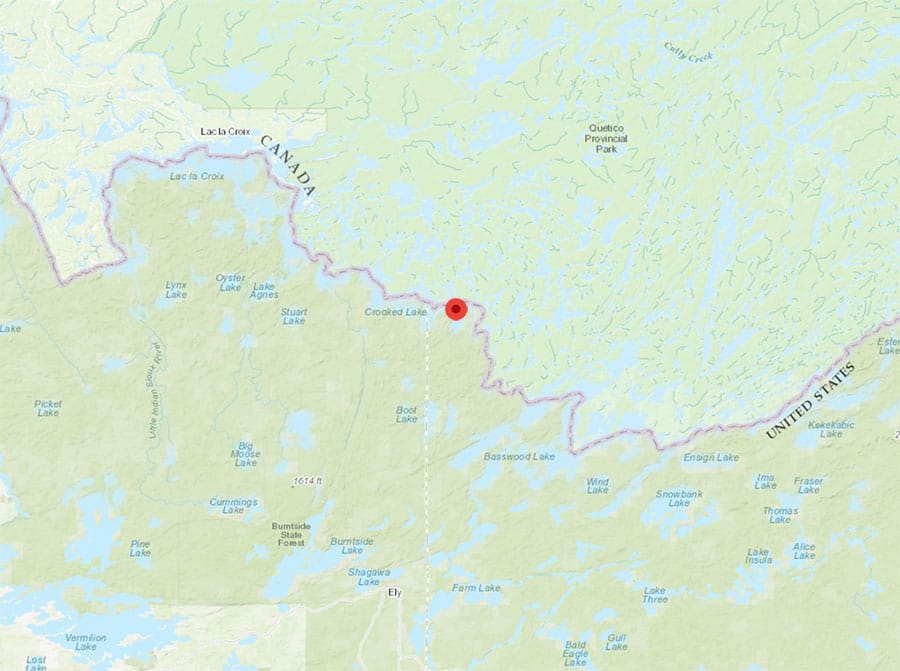
Fire crews suppressed a wildfire on Thursday Bay of Crooked Lake in the BWCAW last week, keeping it to about five acres in size. The Superior National Forest says it was ignited by a “shore lunch” campfire which was apparently made outside an official campsite and fire grate.
The fire was reported on Tuesday, June 2. Firefighters responded immediately and kept it contained. The incident report says it “burned under mature red pines and white pines with a Balsam Fir understory.” As of Friday, June 5, firefighters were still on the scene conducting mop up operations.
It wasn’t the first wildfire of the season. The Forest Service says it has responded to 18 fires across Superior National Forest since April 23. Most fires remained small, from 0.1 acre to 1 acre in total size, but ranged in size up to 20 acres. All were ignited by humans.
“This recent BWCAW fire serves as a reminder that fire danger conditions remain high in the area and everyone needs to remember basic fire prevention practices including making sure that campfires are not left unattended and are out cold before leaving them,” the agency said in a statement.
Fire is a natural part of the Boundary Waters ecosystem. Periodic fire helps forests regenerate, creating the “mosaic” of different aged forests across the landscape that researchers have shown existed before European immigration to the area.
Suppressing for safety
While management plans call for some natural fires in the wilderness to be allowed to burn, human-ignited fires are suppressed unless they meet the criteria of a prescribed burn. Because of the pandemic this year, fire agencies are aggressively responding to fires in the early stages to keep them small and reduce the number of people and resources required.
The Wildland Fire Response Plan, COVID-19 Pandemic, for the Eastern Geographic Area points to these strategies: “Initial attack (IA) fire suppression should be the highest priority for investment of resources,” the plan says. “We must emphasize the need to catch fires during IA and prevent long duration fires.”
Based on data so far, the strategy seems to be working. For the entire eastern part of the county, including Minnesota, the number of fires is average or a little higher this year. With more people enjoying outdoor recreation due to COVID precautions, the risk for human-caused fires is higher than normal.
Already, the number of acres burned is drastically lower than an average of the last 10 years. So far, across the whole region, nearly 25,000 acres have burned. The average total by this date for the past 10 years is 54,000 acres.
Tips from the Forest Service for preventing human-caused wildfires:
- “Shore Lunch” campfires, except in a campsite with an approved fire grate, are illegal and are likely to burn into the soil duff and escape as a wildfire after the camper has left the location.
- Ensure even legal fire grate camp fires are fully extinguished and cold to the touch before leaving the location unattended.
- Don’t dump sauna or wood stove ash with hot embers in the woods around your property.
- Never let children handle fireworks. Any use of fireworks near forested or un-mowed grass areas leads to a high potential for wildfire ignitions
- Never park a vehicle over tall, dry grass (vehicles cause more acreage burned than any other equipment).
- Install spark arrestors on outdoor equipment and recreational vehicles.
- Check for dragging chains before hauling campers or trailers. Dragging safety chains down the road can quickly create sparks, causing roadside grass fires.
- Burning trash is illegal, even in approved fire grates. Burning paper on windy days can easily blow out of the fire grate and quickly start a wildfire in nearby dry vegetation.
More information:
News Release: Superior National Forest and Partners Respond to Wildfires in Northeastern Minnesota


